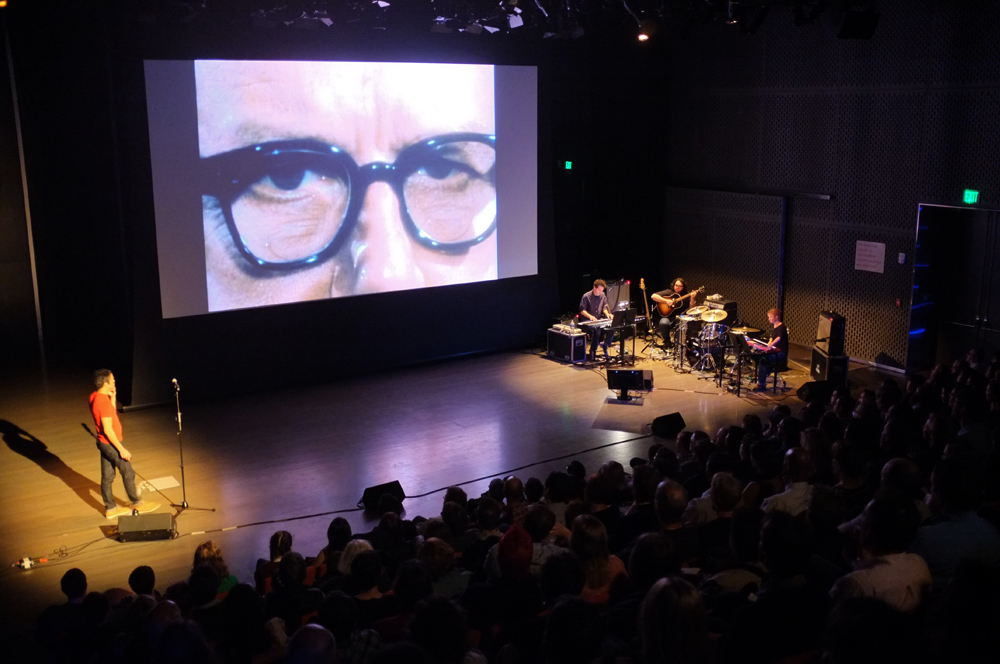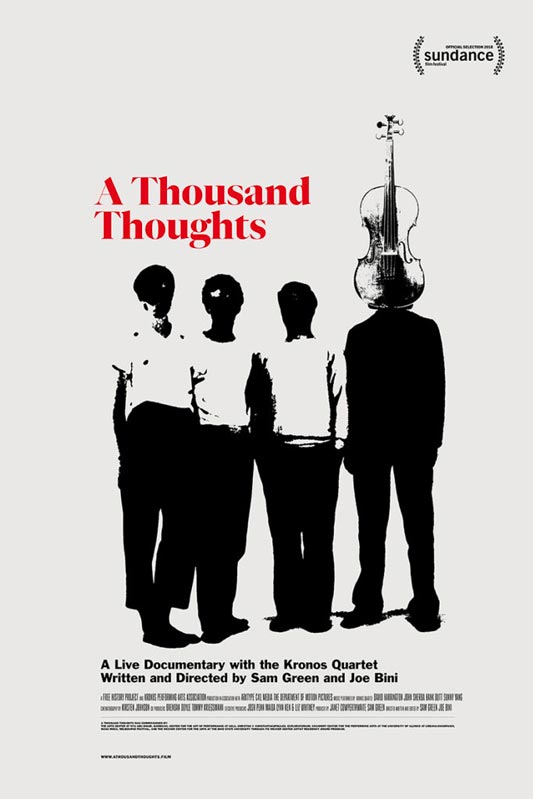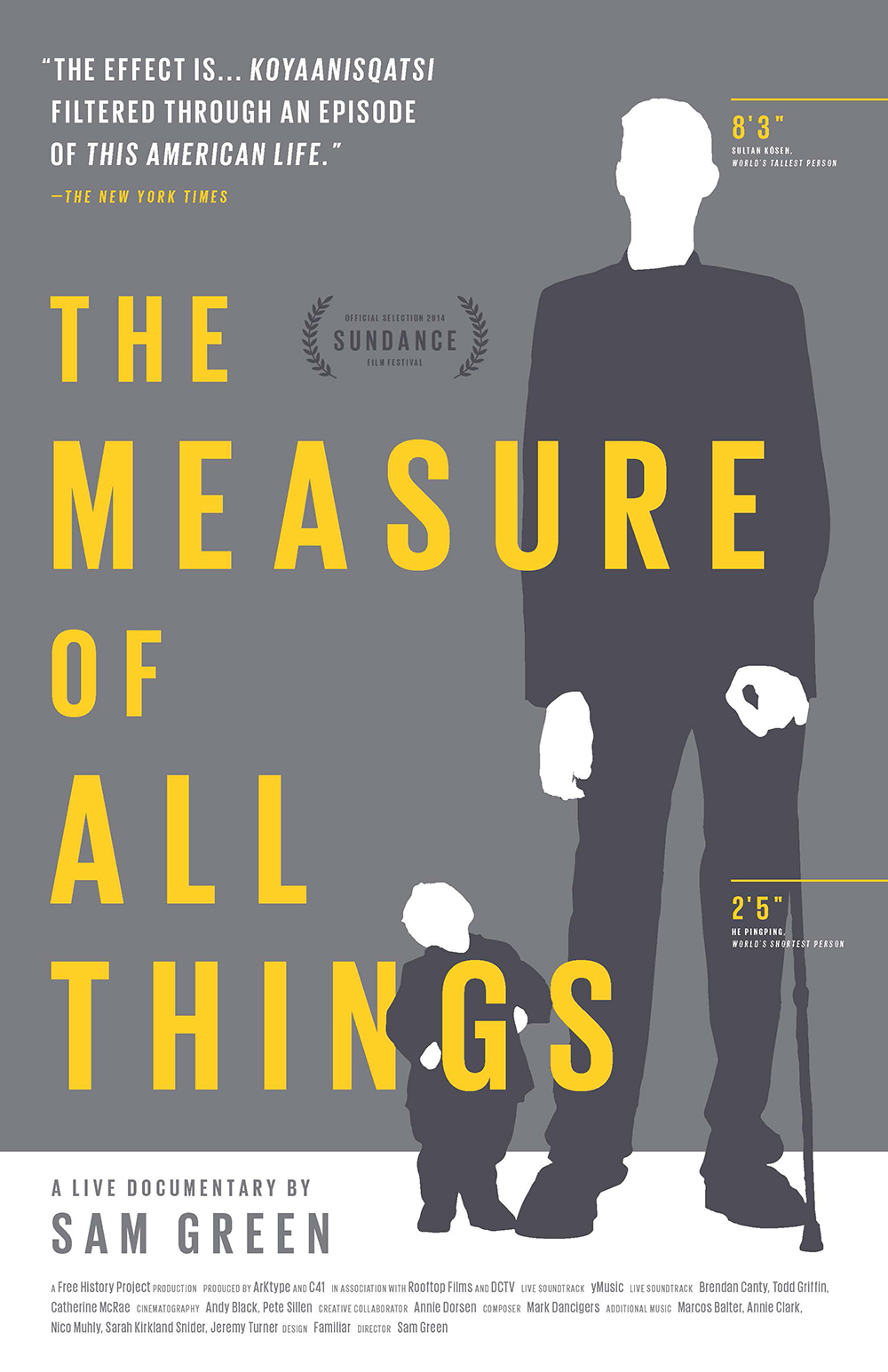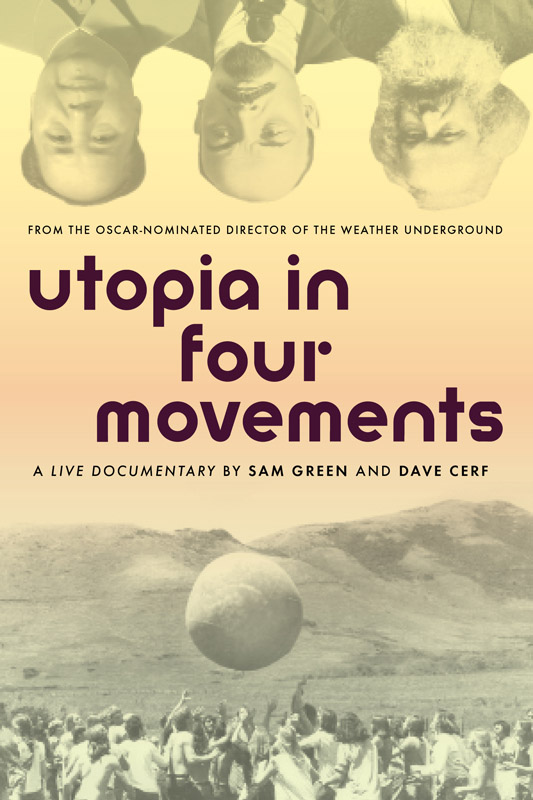“Don’t Call Me Gay Zelig” is a 30 minute live cinema portrait that debuted at the Whitney Biennial in August 2019. The film is about gay activist Jim Fouratt who played central roll in the Stonewall uprising. Live score by JD Samson.
Academy Award®-nominated filmmaker Sam Green (The Weather Underground), in collaboration with Emmy Award®-winning writer and editor Joe Bini (Roman Polanski: Wanted and Desired, Grizzly Man), takes the stage with the legendary classical-music group Kronos Quartet to create a “live documentary” that chronologically unfolds the quartet’s groundbreaking, continent-spanning, multi-decade career. Wildly creative and experimental in form, A Thousand Thoughts is a meditation on music itself-the act of listening closely to music, the experience of feeling music deeply, and the power that music has to change the world.
Green will narrate the piece live onstage while the Kronos Quartet performs the score, and a rich blend of archival footage, photos, and interviews with members of the Kronos Quartet-as well as longtime collaborators like Philip Glass, Laurie Anderson, Terry Riley, Tanya Tagaq, Steve Reich-unspools on screen. The magic of cinema combines with the energy and urgency of live performance to create incredibly rich moments that remind us of the value in the unique, the handcrafted, the ephemeral, and something that is never experienced the same way twice.
A short documentary portrait of the greatest pet cemetery in the world. After its Sundance 2018 premiere, the film was featured on TOPIC and The Atlantic, and made a Vimeo Staff Pick.
The Measure of All Things is a new ‘live documentary’ by Academy Award-nominated filmmaker Sam Green. The film, which will premiere at the 2014 Sundance Film Festival, is a meditation on fate, time, and the outer contours of the human experience. Inspired very loosely by the Guinness Book of Records, The Measure of All Things will weave together a series of portraits of record-holding people, places, and things, including the tallest man (7 feet 9 inches), the oldest living thing (a 5,000 year old Bristlecone Pine in Southern California), the man struck by lightning the most times (seven!), the oldest living person (116), and the woman with the world’s longest name, among others. Drawing inspiration equally from old travelogues, the Benshi tradition, and TED talks, The Measure of All Things will be screened with in-person narration and a live soundtrack. (NB: The Measure of All Things is in no way endorsed, sponsored, or connected to The Guinness Book of Records or Guinness World Records Limited).
Sam Green has been making award-winning short documentaries since the late 1990s. This program gathers together for the first time an evening-length program of Green’s short films, ranging from a portrait of the world’s largest shopping mall in Southern China, which is actually completely empty (Utopia, Part 3), to an elegy for Meredith Hunter, the young man who was killed by Hell’s Angels at the notorious 1969 Altamont concert (lot 63, grave c). Other films from the program include: The Fabulous Stains: Behind the Movie, the remarkable story of the cult film directed by Lou Adler in 1982. The Universal Language is a portrait of Esperanto, an artificial language that was created in the late 1800s with the hope of creating world peace, and the worldwide movement of people who still speak it. Running through Green’s films is a celebration of idealism and the search for meaning along with the often humorous realities of human folly.
Utopia Part 3: the World’s Largest Shopping Mall – 13:08, 2009
Pie Fight ’69 – 8:03, 2000
The Fabulous Stains: Behind the Movie – 11:00, 1999
lot 63, grave c – 9:47, 2006
N-Judah 5:30 – 3:18, 2004
Clear Glasses – 4:13, 2008
The Universal Language – 30:00, 2011
The Love Song of R. Buckminster Fuller is a new “live documentary” by Sam Green featuring a live score by the legendary indie rock band Yo La Tengo.
The Love Song of R. Buckminster Fuller traces the career of twentieth-century futurist, architect, engineer, inventor, and author R. Buckminster Fuller (1895–1983). An early proponent of environmental stewardship, Fuller spoke persuasively about contemporary design and architecture’s ability to tackle issues of sustainability and conservation, and to stimulate radical societal change.
At every screening, Green narrates the film in person and cues images from a laptop while Yo La Tengo performs their original score. The performance is a follow-up to Green’s internationally-acclaimed live film Utopia in Four Movements, which premiered at the 2010 Sundance Film Festival. This new work features the same unique combination of film clips and live music, as Green’s in-person cinematic narration draws inspiration equally from old travelogues, the Benshi tradition, and TED talks.

This 30-minute film traces the history of Esperanto, an artificial language that was created in the late 1800s by a Polish eye doctor who believed that if everyone in the world spoke a common tongue, we could overcome racism and war. Fittingly, the word Esperanto means “one who hopes.” During the early 20th century, hundreds of thousands of people around the world spoke Esperanto and believed in its ideals. Today, surprisingly, a vibrant Esperanto movement still exists. In this first-ever documentary about Esperanto, Green creates a portrait of the language and those who speak it that is at once humorous, poignant, stirring, and ultimately hopeful.
I’ve been to Las Vegas many times and have always experienced a familiar roller coaster of reactions to the city, from being fascinated and seeing it as a profound expression of grand historical forces and liberatory impulses to just seeing it as a totally fucking depressing place. I don’t think I’ve ever had such strong reactions to a city. This film is an expression of much of that and weaves together several elements: a visual portrait of Las Vegas; informal, verite-ish interviews with a wide range of interesting people we came across while shooting; archival images of the city from the 1950s and 60s; along with some first-person voice-over musings about the city and its history. My hope is that this film does justice to the endlessly fascinating, spectacularly libidinous, and deeply disturbing nature of Las Vegas and its history. —Sam Green
This piece was commissioned by David van der Leer and Terry Riley for the “And Then It Became a City” exhibit at the Shenzen Biennial of Design and Architecture.
Throughout human history, people have had giddy dreams and fantastic notions about what the future would bring. Today the future has become more of a threat than a promise—a knot of intractable problems looming menacingly on the horizon. With a powerful sense of poetry, Utopia in Four Movements uses the collective experience of cinema to explore the battered state of the utopian impulse at the dawn of the twenty-first century.
In this “live documentary,” filmmaker Sam Green cues images and narrates in person while musician Dave Cerf performs the soundtrack. From the establishment of a man-made language designed to end war and cultural conflict and the undying optimism of an American exile in Cuba, to the current economic boom in China and the desire to give the remains in mass graves a dignified burial, Green and Cerf sift through the history of the utopian impulse with audiences and search for insights about the way to build a vision of the future based on humankind’s noblest impulses.

Sam Green introduces a “live documentary”
The world is facing so many huge problems and challenges today, that utopia—as a way to illuminate possibilities, stir hope and the imagination—seems more important than ever. Utopia is for this project both a subject and a creative aspiration.
This “live documentary” form—I narrate the film in person and use Keynote to cue images while Dave Cerf mixes a soundtrack on his laptop—started out as just a way to put all the material together and screen it for people, sort of a live rough-cut. But over time, I’ve become quite fond of this as an approach.
The ‘live-ness’ seems especially fitting. At its heart, utopia is almost always about collectivity, about transcending the boundaries of our individual lives to connect with something larger. In this era, when there are so many forces pushing us into private and mediated experiences, the simple act of getting together with other people to talk, catch up, drink, and have a collective experience is a small utopian gesture.
This kind of live event is also a response to the crisis facing cinema today. Most of my students rarely consider going to see a film in a theater. They can see a film more cheaply at home as a DVD or for free on YouTube. It seems as if filmmakers either have to embrace the notion of people watching their work furtively, in stolen moments, on laptops and iPods, or create something that cannot be reduced to a digital file.
I love computers and the Internet, but seeing a movie in a theater with other people has an aura of immeasurable power and plenitude nothing can replace. Something of that collective experience that has been a utopian aspiration has also been a cinematic experience this last century or so, and this event is an attempt to approach both—to describe utopia and to create a kind of conversation of ideas with the audience.
Is nothing American sacred anymore? The largest mall in the world turns out not to be the famous Mall of America in Bloomington, MN—it’s the South China Mall outside of Guangzhou, China. Outdoing the techniques of American consumerism, South China Mall is Disneyland, Las Vegas, and Mall of America rolled into one. There are carnival rides, mini-parks, canals and lakes amid classic Western-style buildings housing space for hundreds of shops.
But along with the glitz and glory of middle-class shopping, the mall’s Chinese developers seem to have imported something else—a cautionary tale of capitalist hubris. Alex Hu, a local Guangzhou boy who made it big in international business, wanted South China Mall to be a hometown monument to his success—even though Guangzhou has no major airports or highways nearby. And four years after its construction, the mall sits virtually empty of both shops and shoppers. But the Chinese have imported yet another concept familiar to Americans—South China Mall is considered too big to fail. So, employees line up for flag-raising ceremonies and pep talks about “brand building” before going off to meticulously maintain the deserted concourses. If China is the future of the world economy, Utopia, Part 3: The World’s Largest Shopping Mall just may be a startling peek at what’s to come.
You can watch the film on PBS here.
This film is a poem of sorts about a pair of glasses that Mark Rudd, one of the former members of the Weather Underground and one of the main subjects of my film on the group, sent me out of the blue a few years ago. He had been wearing that specific pair of glasses when he turned himself in in 1977 and I recognized them from news footage and photos of the event. He sent me the glasses as a way to say thanks for making the film.
I loved the glasses. It was as if he had somehow read my mind, or my person, and figured out the gift that would thrill me almost more than anything else. I definitely find myself enthralled by certain objects.
I think that what I like so much about Mark Rudd’s glasses is the fact that these are the very same pair of glasses that I’d seen on the cover of the New York Times. This was the actual object. There was something magic about that. Just like the Claxton Mailbox. I couldn’t quite figure out how, or why this was the case.
Whatever it was, I felt like this fascination was somehow at the root of my documentary filmmaking—this obsession with realness and the real thing. I was drawn to Mark Rudd’s glasses in the same way that I was drawn to the Rainbow Man and his story, or Meredith Hunter’s unmarked grave, or the world’s largest shopping mall that is oddly enough a total failure, or a piece of footage that I used in The Weather Underground showing hippies burning dollar bills with looks of great ecstasy on their faces.
So with Clear Glasses I was trying to somehow get to the bottom of all of this—to create a serious meditation on the complex web of impulses that inspire my work. But when I showed the finished piece to my girlfriend for the first time, she laughed and said she thought it was a funny piece! I was completely surprised. I don’t make funny films! I got similar responses to Clear Glasses from other people, and over time, I chalked it up to one of the fascinating truths about filmmaking: that the meaning of a film is created for the most part by the audience and that a filmmaker can often be surprised by how his or her work is perceived. Oh well, so much for a serious meditation. But I was able to try out several new things with Clear Glasses, and so in many ways I see it as a warm-up exercise for the first-person essay film I made the next year, Utopia In Four Movements. —Sam Green
lot 63, grave c is a short documentary film about Meredith Hunter, the teenager who was killed by Hell’s Angels at the Rolling Stones’ notorious Altamont concert in 1969.
Altamont was supposed to have been the west coast version of Woodstock, the huge peaceful rock festival that had happened in New York a few months earlier. Instead, the concert turned into a Hieronymus Bosch-like orgy of bad trips, stupid rock fans, poor planning, and tons of violence. It culminated with the Hell’s Angels, who had been hired to do security, brutally murdering Meredith Hunter in front of the stage as the Rolling Stones played.
Altamont came to symbolize for many the end of the 1960s – the end of a hopeful era. Meredith Hunter is the central character in that narrative, and yet he has always been an enigmatic figure. Although the newspapers at the time recorded his name, there was never anything more – no photo, no quote from his devastated mother. He was a mystery then, and now has been all but forgotten.
lot 63, grave c has screened at the following film festivals: Sundance, Rotterdam, Ann Arbor, San Francisco, Black Maria, Nashville, Los Angeles, Seattle, PDX, Tekfestival (Rome), Silverlake, and the Dallas Video Festival.
A portrait of the streetcar that passed in front of Green’s apartment in San Francisco for many years.
Fueled by outrage over racism and the Vietnam War, the Weather Underground waged a low-level war against the government throughout much of the 1970s—bombing the Capitol building, breaking Timothy Leary out of prison, and evading one of the largest FBI manhunts in history. The Weather Underground is a feature-length documentary that explores the rise and fall of this radical movement, as former members speak candidly about the idealistic passion that drove them to “bring the war home.” Starring Bernardine Dohrn, Bill Ayers, Mark Rudd, David Gilbert, Brian Flanagan, Laura Whitehorn, Naomi Jaffe Kathleen Cleaver, and Todd Gitlin.
On Wednesday night, October 22, 1969, a delivery truck arrived at the front of Masonic Auditorium, amidst the glamour and clamor of the opening night of the San Francisco International Film Festival. The driver, a husky pastry chef, apparently in a hurry, attempted to run a huge tray of creamy pies up the red-carpeted stairs. In the rush, the precarious arrangement of pies went flying, and, almost magically, the oddest assortment of characters descended—a nun, a football player, and a go-go dancer among them. What ensued was a most memorable yet virtually forgotten piece of San Francisco’s cinema history.
Led by late filmmaker Peter Adair (Holy Ghost People, Word is Out), the band of radicals called themselves Grand Central Station. Their hope was to create a huge splash—a media event that would attract investors to the group’s numerous, unfunded feature-film projects. Staging a silent-era pie fight at the black tie event was also a perfect way to protest the bloated, bourgeois affair the Festival had become.
Equipped with some half a dozen cameras, the group, numbering nearly thirty, emerged from the crowd of tuxes and gowns once the delivery truck (with “Grand Central Station Pies” printed on the side) arrived. As jesters, nuns, and mimes flung pies, towels, printed with the Grand Central Station manifesto, were supplied to any bystanders that got creamed. The pastry melee splattered across headlines for two days (“Hippies Invade Film Festival”); even Mayor Alioto heightened the coverage by wanting to charge the no-goodniks with a felony.
Despite the huge amount of publicity generated by the pie-fight, no movie offers came in for Grand Central Station. Several months later, the members of group all went their separate ways. And the rolls of film they shot of the event were lost for almost 30 years, until San Francisco filmmaker Bill Daniel discovered them recently in an unmarked box sitting in a corner at Artist’s Television Access, an underground film venue.
Pie Fight ’69 documents this wacky event, constructed from the original footage shot by Grand Central Station and from news coverage and personal accounts. Preserving the seat-of-the-pants flavor of the pie tossing, Pie Fight ’69 attempts to bookmark a nearly forgotten moment in 60’s counter-cultural radicalism, as well as set a page in the histories of San Francisco’s underground film community and the SF International Film Festival.
Sarah Jacobson (1971–2004) was a legendary San Francisco underground filmmaker, as well as a great pal and inspiration. Sarah was extremely passionate about things––when she was interesting in something, she made the world stand up and take notice. In the early 2000s, Sarah become obsessed with the 1981 cult film Ladies and Gentlemen, The Fabulous Stains. I had never even heard of the movie, but when Sarah showed me a bootlegged VHS copy, it blew my mind. The Fabulous Stains is definitely one of the weirdest movies ever made, but weird in a fascinating way! The congruence of people and social forces that came together in the film, not to mention the ambition and failure and all that…
Anyway, Sarah pitched doing a piece about The Stains to John Pierson, who had a TV show about indie film on some cable channel at that time. John liked Sarah and loved the idea for the piece––I think he’d actually even shown The Stains way back in the early 1980s.
Sarah didn’t have a lot of experience with documentary, so she asked me to work with her on the project. It ended up being a real collaboration, and I learned a lot from Sarah. She was meticulous about music editing, and also had very strong opinions in the edit room. Needless to say, we fought! But we had a great time making the piece, and I still think of it, and my time working with Sarah, fondly.
And thanks entirely to Sarah’s tireless championing of The Stains, in 2008 Rhino recently re-released it.
Millions of Americans have seen Rollen Frederick Stewart, a.k.a. “Rainbow Man,” a man who achieved notoriety during the late 70s by appearing in the crowd at thousands of televised sporting events wearing his trademark rainbow-colored afro wig. Later, after he became a born-again Christian, he added a sign reading “John 3:16.” Over the years, grabbing the attention of the media became an obsession for Stewart. He abandoned his home and marriage to roam the country living out of his car, studying TV Guide each week in a never-ending quest to stay televised… with tragic consequences. “More than an exploration of life, The Rainbow Man is a parable about alienation, the media, and the meaninglessness that often defines American life.” – Trevor Groth, Sundance Film Festival




